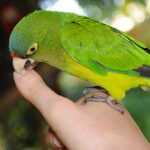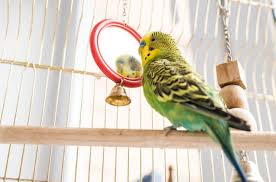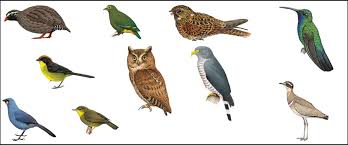As a devoted bird parent, you want to give your feathered family members the best possible quality of life. This includes setting up a cozy cage with everything they need, feeding high-quality foods, and spending time building your bond together. But have you ever wondered whether your pet bird is bored in their cage?
Just like humans, birds can experience moments of boredom and restlessness. When unaddressed, it can lead to behavioral issues. We’re here to help! Avoid problems and provide your bird with the entertainment and mental enrichment they need by following these tips:
Does a Bird Get Bored in a Cage?
Yes, they definitely can! When people are introduced to raising and caring for birds, we often stress the importance of a secure, comfortable cage for them to live. While this habitat is essential, focusing specifically on the cage may have set many bird parents up for failure. Why? Because simply having a nice cage isn’t enough to keep your bird happy. For the best quality of life, you must find ways to provide mental enrichment opportunities for your bird.
How Can You Tell if Your Bird is Bored?

One of the best things you can do for your bird’s mental health and happiness is learn how to identify if your bird is bored. By recognizing the symptoms early, you can then make changes to your bird’s lifestyle, routine, and habitat to address the problem head-on.
The sooner you eliminate the boredom, the more likely you are to prevent any potential problems that boredom may cause, such as self-destructive behaviors, aggression, or damaging your home and belongings. Ultimately, if a bird is left to feel bored or lonely for too long, it can seriously impact their overall well-being, leading to health problems and potentially loss of life.
The most common signs that a pet bird is bored include:
- Excessive screaming and vocalization
- Pacing
- Withdrawal or uncharacteristic reluctance to be handled
- Sudden lack of activity
- Weight gain and obesity
- Biting or lashing out
- Feather plucking or skin picking
- Loss of appetite
- Appearance of stress bars on your bird’s feathers
If you notice any of these signs or any other sudden and unexplained behavioral changes, you should start with a call to your avian veterinarian. Explain your concerns and the changes that you have noticed. They can make an appointment to run tests and rule out potential medical explanations for the behavior.
Once you are sure there is no medical cause for your bird’s behavior, you can focus on providing new enrichment and entertainment opportunities.
7 Ways to Entertain Your Pet Bird
The good news is that there are many ways you can provide enrichment for birds, eliminating boredom and improving their overall quality of life. I have compiled this list of ideas and inspiration to help you get started. If you try one option that doesn’t work, move on to another.
Take note of the games and activities your bird enjoys most, but also switch it up. Even a loved activity can become tedious if you rely on it too much.
Give Your Bird More Out-of-Cage Time:

Your bird’s cage should be a safe, comfortable place for them to rest and relax, but they shouldn’t be forced to spend all day, every day, within the confines of those cage walls. Make time in your day to let your birds come out, stretch their wings, and spend quality time together.
This is also an excellent time for them to enjoy the mental enrichment of exploring their surroundings, even if they are in your living room or around your home. If you really want to take this suggestion to the next level, consider purchasing a harness for your bird to take them outside safely to explore.
Consider Socialization Opportunities:

Birds are often marketed as pets that are happy to be on their own in their cages, but the truth is that most bird species are highly social. Simply allowing your bird to socialize with you, your family members, or even other birds may prove beneficial. There are even studies showing that parrots love video-calling other birds!
Turn On the TV:
If you can’t be around for a long time but still want to help your bird eliminate boredom, one easy solution is to play engaging videos on your television or computer. You can turn on videos that show birds fluttering about and chattering, giving the illusion of having other birds nearby if your bird enjoys the company of others.
On the other hand, if your bird is stressed by the presence of other birds (as some species are), switch it up by playing videos with people talking or other comforting sounds. Remember, no two birds are the same, and that’s okay! Pay attention to which videos trigger a positive reaction from your bird and which don’t, and set up a playlist that considers their interests.
Turn Mealtime into Fun Time:

Do you feed your bird by just placing a bowl of birdseed on the side of their cage? If so, you’re missing an easy opportunity to incorporate enrichment for birds into your daily routine. Try using foraging toys or food puzzles to challenge your bird’s mind. These products encourage birds to tap into their instincts, searching out their food and figuring out how to access it. Ultimately, they are rewarded for their efforts with their meal or treats.
Are you trying to find a solution on a budget? Another option is to make homemade bird foraging toys using items you have around the home. Try rolling up your bird’s food in fabric or newspaper or placing it inside an empty paper towel roll before folding the edges in. Just be sure to supervise your birds while they are playing to ensure they aren’t ingesting anything they shouldn’t.
Rotate Toys Regularly:

Collect all your bird’s toys and separate them into 2 or 3 groups. If you have similar toys, split them up. For example, if you have two different types of hanging mirrors, place one in each group. When you’re finished, put one group of toys in your bird’s cage and store the rest somewhere they can’t access them. This may seem counterproductive, after all – you’re taking toys away from your bird, but stick with me here.
After your bird has had the chance to play with their current group of toys for a couple of weeks, remove them and give them another grouping; by the time you put this new group of toys into the cage, they will all feel “new” and exciting again. This is a great way to make the most of the money you have invested in your bird’s toys. After all, like most pet products, bird toys can be expensive!
Supply Your Bird with Something to Chew On:
Some bird species, like parrots, are known for their desire to chew. If your bird falls into this category, here is an easy way to offer some enrichment and reduce the risk that your bird will fill this need by chewing on random options around your home (or your fingers). There are many great chew toys made specifically for birds.
When selecting a toy, pay careful attention to the type of wood that it is made from. Hardwoods like pine are a great option for larger birds and heavy chewers. But for birds that need something softer, select a wood chew made from a softer material like yucca wood or balsa wood. Not only do these chew toys add enrichment to your bird’s habitat, but they also play an essential role in beak and nail conditioning.
Expand Their Habitat:

Do you work a job that keeps you away from home for longer hours? If so, you may be searching for options to enhance your bird’s experience while in their cage. One way to reduce boredom while still in the cage is to upgrade to a larger cage. This will provide your bird with more room to move around and exercise. It will also offer more space to introduce toys, interactive elements, and other enrichment opportunities. While you should prioritize getting your bird out of the cage at least once a day, this will help improve their time in the cage while you’re away.
For those who are really committed to providing your bird with more room to move about, you may also be interested in training your bird to live without a cage. Some bird parents will dedicate an entire room to their birds, decorating it with bird-friendly options and plenty of activities they can enjoy even if they are home alone. Of course, it will take some training to avoid having your bird mess all over the room or try to fly away.
Final Thoughts:
If you suspect your pet bird may be bored in their cage, take a moment to reflect on their recent behaviors. Have you noticed any behavioral changes or signs of boredom, as outlined above? If so, it’s time to step up and make a change before it’s too late. After all, boredom itself isn’t a disease that will harm your bird, but it can lead to severe and potentially life-threatening compilations due to stress.
Focus on introducing engagement opportunities into your bird’s life. This can be done by adding new interactive elements to their cage (like new ladders and other areas to explore), expanding the size of their cage, introducing foraging toys and food puzzles, spending quality time socializing with your bird, or training your bird to perform some fun and entertaining tricks. If your schedule is currently too busy to give your bird the time they require to live a happy, fulfilled life, consider hiring a pet sitter to come in during the day and spend some quality time with. Even a half hour each day while you’re at work can significantly impact your bird’s emotional and mental state.






























































One thought on “How Can you know if your Bird is Bored in the cage?”